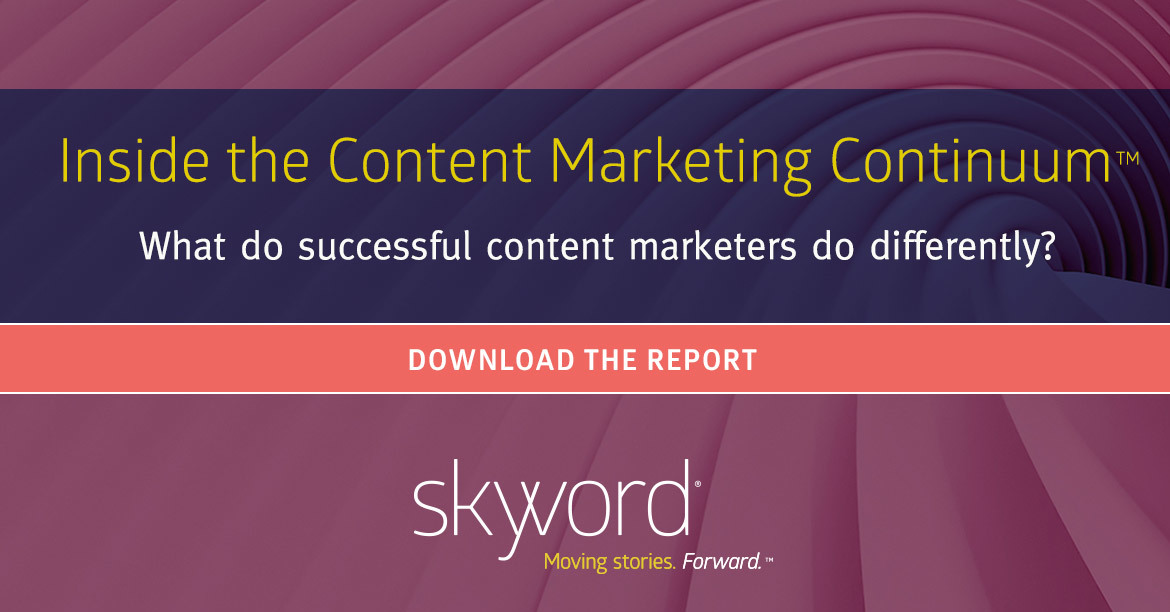Creativity
Why Only 10 Percent of Content Marketers Have Embraced Brand Storytelling
By Taylor Holland on January 24, 2018
My husband recently helped me do research about an upcoming event-a major convention for a truly exciting industry. I was writing an article about what event attendees could expect, so he reviewed exhibitor blurbs on the convention website.
When I asked what he'd learned, he frowned and said, "I'm having trouble finding anything useful in all this marketing crap." Then, remembering that I work in marketing, he added, "I'm sorry. There are just a lot of buzzwords and corporate speak and bragging. I don't know how you do it."
"I don't," I scoffed. "I do brand storytelling."
Truth is, I also do other types of content marketing-tips-based articles about health and wellness, blog posts about technology trends, and even occasionally event copy. But none of it is full of buzzwords and corporate speak and bragging. That's the beauty of content marketing-most brands now put time, money, and effort into sharing information that their audiences want to read, information they would go searching for or that they're glad to stumble upon.
Some bad event promo copy aside, new research from Skyword shows that most brands now have a solid content marketing strategy. They're considering the customer journey, engaging their audiences, and even telling stories here and there. However, few organizations have fully embraced the next evolution of marketing-storytelling.

Brand Storytelling Isn't New, but It Is a New Priority
Storytelling isn't a new concept in marketing. Throughout the history of branding, storytelling has always been an important tool-a way to earn customer loyalty and create more engaging commercials. It's just never been the most important tool. Product statements, competitor slamming, and buzzwordy braggadocio were usually the go-tos. Then content became king, and brands learned how to think like editors and publishers, not just salespeople.
The new challenge: thinking like storytellers.
Image attribution: Avi Richards
It's a challenge most brands are at least attempting to meet. Over the past few years, marketing experts and data scientists have effectively convinced leaders about the value of storytelling. You know the spiel: Stories are more engaging and memorable to the human brain, which is hardwired to prefer stories. Stories stand out in the sea of advertising and content that consumers have learned how to ignore, and that technology often enables them to filter out entirely.
Yes, the idea of storytelling has become all the rage in marketing. Leaders across industries are talking about it, but how many are actually doing it? About 10 percent.
Skyword spent much of 2017 conducting a comprehensive study of just shy of 1,000 content marketers. One of the major findings from the report was how few content marketers are genuinely embracing storytelling. However, when you look at the top-performing content marketers alone, that number skyrockets to 52 percent.
Clearly, the most advanced marketing teams are more apt to use storytelling, but why? What's keeping everyone else from taking this step? Why does the use of storytelling track so closely with the sophistication of the content marketing program? And what can we learn from the storytelling success of top performers?
4 Reasons Brands Don't Tell Enough Stories
If storytelling is so great, why isn't it a bigger focus for most brands?
1. Storytelling isn't part of the culture or marketing mindset
Many companies understand the value of storytelling and aim to tell stories, but most see stories as a type of content-a box to check off, something to experiment with, "light" content to balance out the data-filled article, salesy case studies, and serious thought leadership blogs.
Marketers at what Skyword calls "storified organizations" don't just think of stories as a type of content, but a way to approach content creation. And therein lies the difference between competent content marketing and masterful content marketing.
To better understand marketing challenges based on an organization's maturity level, Skyword stratified survey respondents into five categories: Bystanders, Novices, Experts, Leaders, and Visionaries. In Skyword's study, Visionaries were very likely to say a storytelling ethos permeates their organization. Far fewer Leaders reported the same.
Just as importantly, Visionaries' values permeate their storytelling. They don't just create content to answer questions or provide useful information. They see storytelling as a way to tell customers who they are and what matters to them. And that's powerful stuff, especially when customers share those values.
2. Storytelling is a new skill set
Telling stories is instinctive. It's how we talk, how we remember, how we organize experiences in our brains. But writing stories is a different matter. It's a skill, and developing any new skill takes time, instruction, practice, and experience. It's also an art form, so doing it well takes some degree of natural talent.
Simply put, to tell stories like writers, rather than talking about products like advertisers, many content creators have a lot to learn about brand storytelling. But before marketing teams can get the training they need, everyone must first acknowledge that need.
Image attribution: Clem Onojeghuo
Robert McKee, author of Storynomics and arguably the world's leading expert on storytelling, put it this way in an interview with the Content Standard:
They all have this one big problem: they have to realize there is a craft that underlies this and they have to master that craft … They have to have an author's knowledge of the art form. That's the hardest thing for them to get through their heads: here they are, at age twenty-five, thirty, and they thought they'd done all the schooling they needed to do. That they could just sit down and be a writer, a businessman, and that they didn't have to start learning from the beginning … That's a big step: to knuckle down and realize, I don't know. I have to learn. I have to study this. Once you get them past that-when they realize it's a profession and not a hobby-who knows where it will take them.
Of course, before it can take them anywhere, they need opportunities and resources to learn and hone the craft. Marketing leaders who truly want their teams to master storytelling help them find those opportunities.
3. Storytelling isn't a documented part of the process
Training storytellers with a storytelling mindset is a great start, but what role does storytelling actually play in content creation? Is storytelling a suggestion or an expectation? How should writers approach customer success stories and case studies so that they read like stories rather than long testimonials? How do they write blog posts that feel like news stories and not press releases? How do they design infographics in a way that tells a story, rather than just listing related data points?
These are key questions that organizations must answer for their content creators, preferably in writing. Yet, Skyword found that less than a third of marketers use both brand standards and editorial guidelines-both of which are critical for companies making the transition from traditional marketing to storytelling.
Brand standards are more common. While editorial guidelines are rarer, they are perhaps more important for storytelling, because they provide writers with insights into the audience, the brand's voice, and the types of content the organization creates. They also address structure and tone of voice-key storytelling elements-as well as journalistic issues such as stylistic consistency, sourcing, and fact-checking.
Skyword found that Leaders and Visionaries-those content marketers who are most advanced and most effective-are more likely to use these documents. Nearly all Visionaries (96 percent) use brand standards and editorial guidelines, compared to less than half of Experts, and most Visionaries address effective storytelling in those guidelines. Of those with the most advanced editorial guidelines, 85 percent say they consistently use storytelling techniques, proof that a documented and "storified" content marketing strategy leads to more (and better) stories.
Image attribution: Corinne Kutz
4. Storytelling is not properly measured
The most advanced marketing leaders view story as a strategic asset with long-term value, and they measure it as such. Among all the respondents in Skyword's survey, traffic is the most common metric that content marketers track and use to evaluate success.
Visionaries see things differently. They pay the least attention to traffic and instead focus on KPIs related to audience growth, sustained engagement, and content value. They understand that quality of customer connections is more valuable than quantity of clicks and eyeballs. They also have a strong understanding of how their KPIs impact sales and are more likely to use content marketing technology that can provide such sophisticated analytics.
These types of metrics better inform the overall content marketing strategy and help teams understand how to tell stories in a way that generates business value. They also help marketing leaders justify (and grow) their content budgets, so they can tell more and better stories across channels and mediums.
In doing so, these leaders also help make the business case for storytelling, and as more and more of their peers get the message, content marketing will continue to evolve into its purest, most effective state: a darn good story.
For more information, download Skyword's Inside the Content Marketing Continuum research report.



